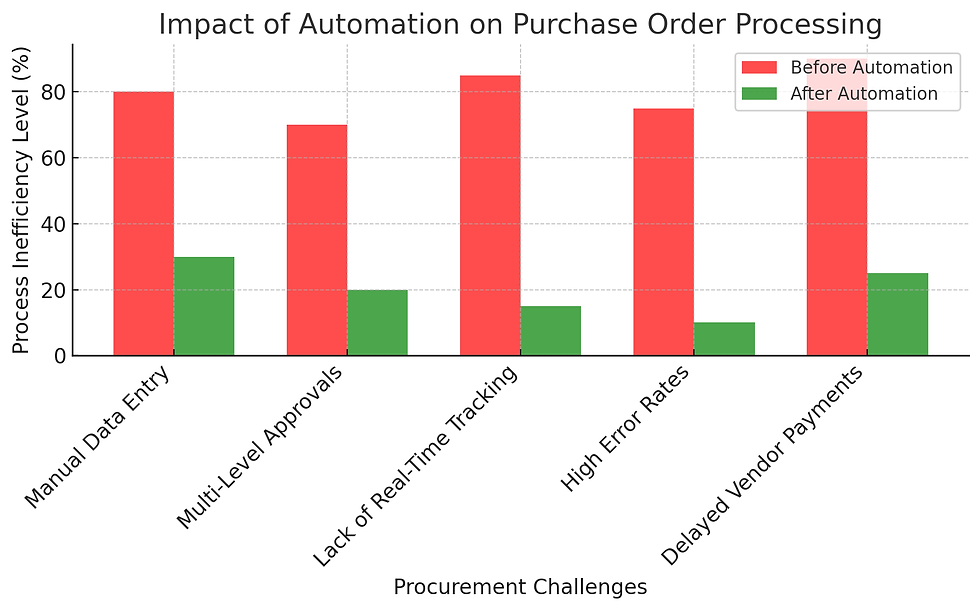Procurement Best Practices: How to Streamline Purchase Orders for Maximum Efficiency
- Sandie Tirado

- Feb 27
- 3 min read
🚀How many times has a delayed purchase order disrupted your operations? Whether it’s stalled approvals, misplaced documents, or manual inefficiencies, procurement teams constantly battle PO bottlenecks that slow down operations, increase costs, and create compliance risks.
The good news? Automation is changing the game. By eliminating inefficiencies, enhancing real-time visibility, and ensuring seamless approval workflows, businesses can cut processing time, reduce errors, and maximize cost savings.
Procurement plays a critical role in driving business success, but slow PO cycles can lead to cash flow issues, supply chain disruptions, and unnecessary operational expenses. Understanding where the bottlenecks occur and how automation can solve them is key to streamlining procurement workflows and improving efficiency. Let’s explore how businesses can transform their PO processes for maximum impact.

1️⃣ Identifying Common Bottlenecks in Purchase Order Processing
Many organizations struggle with slow, error-prone purchase order cycles, often caused by:
🔹 Manual Data Entry & Paper-Based Processes – Relying on spreadsheets or paper-based approvals slows down PO creation and increases the likelihood of errors.
🔹 Lack of Standardization – Disorganized PO approval workflows and inconsistent supplier management create unnecessary delays and confusion.
🔹 Inefficient Approval Chains – When too many stakeholders are involved, POs get stuck in approval limbo, delaying procurement timelines.
🔹 Poor Visibility & Tracking – Without real-time PO tracking, finance and procurement teams struggle to ensure timely payments and order fulfillment.
🔹 Duplicate or Incomplete Orders – Lack of centralization often leads to duplicate purchase requests or missing vendor information, requiring rework.
2️⃣ The Power of Automation in Purchase Order Processing
By leveraging procurement automation tools, businesses can eliminate bottlenecks, reduce human error, and improve efficiency. Here’s how:
✅ Automated PO Creation & Approval Workflows
Implementing cloud-based procurement systems (like SAP Ariba, Oracle Procurement Cloud, or Coupa) ensures that POs are generated, submitted, and routed for approvals automatically.
Pre-configured approval hierarchies reduce time spent waiting for signatures, ensuring POs move through the system quickly.
✅ Real-Time Tracking & Spend Visibility
Procurement automation allows real-time PO tracking and provides insights into spend trends, vendor performance, and approval status.
Dashboards enable finance and procurement teams to identify and resolve PO issues before they cause major disruptions.
✅ Integration with Vendor Management Systems
Automated procurement tools integrate directly with supplier portals, reducing miscommunication and ensuring vendors receive accurate POs instantly.
Vendor onboarding workflows help validate supplier credentials and compliance, avoiding approval delays.
✅ AI & Machine Learning for PO Optimization
AI-driven procurement systems detect potential order errors, flag duplicate orders, and recommend cost-saving measures.
Predictive analytics enable procurement teams to forecast purchasing needs, preventing supply chain disruptions.
3️⃣ Best Practices for Maximizing PO Efficiency
🔹 Implement Clear PO Policies & Standardized Workflows – Establish company-wide best practices for purchase order creation, approval, and tracking to reduce confusion and delays.
🔹 Adopt a ‘No PO, No Pay’ Policy – Require all purchases to go through an approved PO system to eliminate rogue spending and ensure proper financial oversight.
🔹 Set Up Automatic PO Approvals for Low-Value Transactions – Reduce unnecessary delays by configuring automated approvals for low-risk, low-cost POs while keeping stricter oversight for high-value orders.
🔹 Leverage Procurement Dashboards for Data-Driven Decisions – Use analytics dashboards to monitor procurement performance, identify inefficiencies, and track spend trends over time.
🔹 Regularly Audit and Optimize Procurement Workflows – Conduct quarterly procurement process reviews to refine approval workflows and eliminate inefficiencies.
Final Thoughts
By eliminating manual inefficiencies and leveraging automation-driven procurement processes, organizations can significantly reduce purchase order processing time, improve cost control, and enhance supplier relationships. A streamlined PO system not only accelerates procurement cycles but also strengthens financial governance and operational agility.
🚀 Want more procurement insights? Follow me on LinkedIn!



Comments